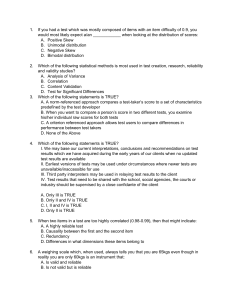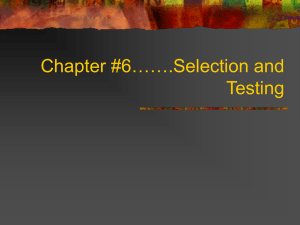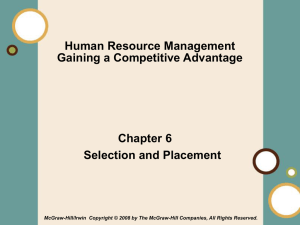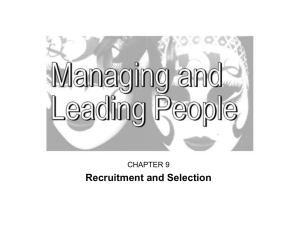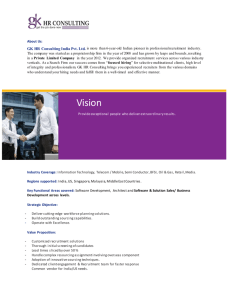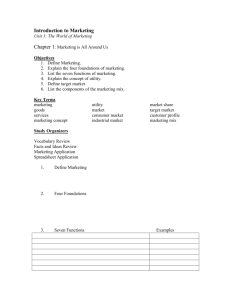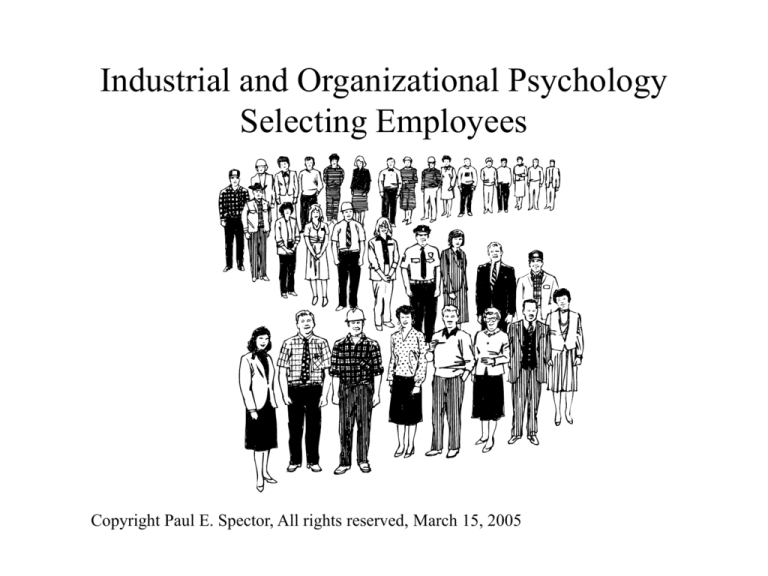
Industrial and Organizational Psychology
Selecting Employees
Copyright Paul E. Spector, All rights reserved, March 15, 2005
Selection Problem: Choose the Best Person
For the Job
• 1. Best performer
• 2. Best social fit (team player)
• 3. Best person-job fit (worker adjustment/wellbeing)
• Empirical process: Data based and objective
• Legal process: Government regulation and law
• Utility: Benefit of using a selection procedure
Hiring Process
Planning and Recruitment
• Planning: Anticipating needs for human resources
– Expansion vs. replacements
– Labor markets
• Recruitment
–
–
–
–
–
–
Advertising
Employee referral
Employment agencies
School recruiters
Walk-ins
Web (Monster website)
Preliminary Concepts
• Reliability
– Test-retest
– Internal consistency: Multiple items required
•
Validity
– Criterion related
• Concurrent vs. predictive
–
–
–
–
Content
Face
Convergent vs. Discriminant
Construct: Overall case necessary for legal defense
Making Selection Decisions
• Human judgment: Hire whoever seems best
•
I/O approach: Use empirically (research-based) proven assessment
methods
• Steps involved in I/O method
–
–
–
–
–
–
•
•
1. Analyze job
2. Define criteria
3. Define abilities needed
4. Choose potential predictors
5. Validate (determine equation)
6. Cross-validate
Multiple cutoff option: Must meet each selection requirement
Multiple regression: Must achieve a certain total score regardless of
performance on each requirement
• Validity generalization: Effective selection devices work in all settings
Utility
• Value of selection system to the organization
• Cost/benefit ratio
• Utility is maximized by
–
–
–
–
–
1. Validity of selection device—should be high
2. Selection ratio (hired/applicants)—should be low
3. Baseline for success—should be 50%
4. Cost of selection program—should be low
5. Cost of bad selection (recruitment, training, low productivity)—should
be high
• Hunter-Schmidt programmer aptitude test for federal government
–
–
–
–
Cost: $6000/year
Estimated gain: $5.6 million to 97.2 million
If universally adopted could save $1.5 billion in U.S.
However, this assumes unlimited supply of applicants and no constraints
on performance in organizations
Utility Example
Legal Issues
• Civil Rights Act (1964) prohibited discrimination
• Equal Employment Opportunity Commission, EEOC
charged with overseeing compliance
• Uniform Guidelines for Employee Selection (1978).
• Adverse impact (80% rule based on selection ratios)
• Discrimination Case based on
– Adverse impact
– Invalid selection/placement procedures
– Job irrelevance
– Lack of business necessity
Affirmative Action
• Required of all organizations with > 50 employees or government
contracts > $50,000
• Includes universities with grants
• Requires a plan to increase female and minority representation
• Hiring unqualified forbidden by Supreme Court
• Preferential Treatment
–
–
–
–
–
Not required except under unusual circumstances
E.g., organization unwilling to practice fair selection
Can have negative effects
Beneficiaries--poor self-image
Nonbeneficiaries--negative attitudes and resistance
Americans With Disabilities Act of 1990
• Extends civil rights protection to disabled
• Similar to Civil Rights Act in how it works
• Reasonable accommodation
– What is reasonable?
• Essential functions
Solutions To Problems of Discrimination
• Objectivity in selection procedures
• Focus on job relevant characteristics
• Panel interview with diverse membership (PrewettLivingston et al., 1996)
• Training of people who make selection decisions

